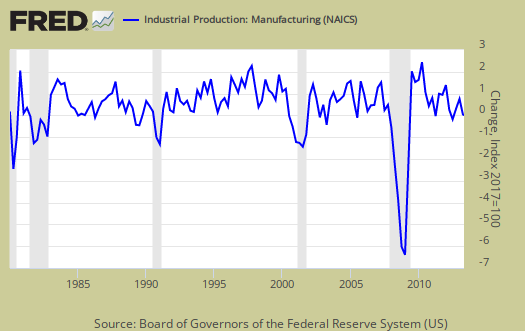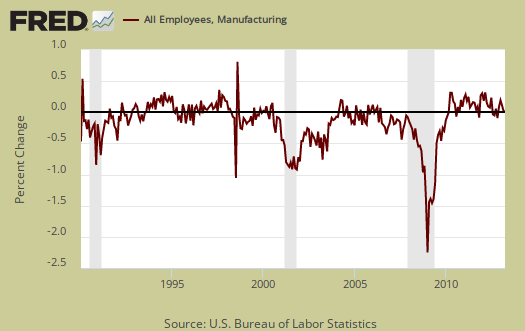The May ISM Manufacturing Survey shows PMI crumbled by -1.7 percentage points to 49.0%. Manufacturing has moved into contraction. Manufacturing also contracted in November 2012 and previous to that, July 2009. Both new orders and production contracted indicating bad news for the U.S. manufacturing sector and the index details are even more ominous.

Comments from manufacturing survey responders implied general weak economic demand. Weak demand was from less Government spending, domestic weak demand and both Europe and China's downturn were mentioned as a cause for the contraction.
New Orders contracted, a -3.5 percentage point increase to 48.8%. That's bad news in terms of future growth. New Orders last 49.7% contraction was in December 2012.
A New Orders Index above 52.3 percent, over time, is generally consistent with an increase in the Census Bureau's series on manufacturing orders.
ISM gives an ordered list of manufacturing groups who show growth to decline in new orders:
The seven industries reporting growth in new orders in May — listed in order — are: Printing & Related Support Activities; Nonmetallic Mineral Products; Fabricated Metal Products; Food, Beverage & Tobacco Products; Wood Products; Furniture & Related Products; and Machinery. The eight industries reporting a decrease in new orders during May — listed in order — are: Apparel, Leather & Allied Products; Miscellaneous Manufacturing; Plastics & Rubber Products; Petroleum & Coal Products; Transportation Equipment; Paper Products; Chemical Products; and Computer & Electronic Products.

The Census reported manufactured April durable goods new orders growth was 3.3%, where factory orders, or all of manufacturing data, will be out later this month, but note the one month lag from the ISM survey. The ISM claims the Census and their survey are consistent with each other. Below is a graph of manufacturing new orders percent change from one year ago (blue, scale on right), against ISM's manufacturing new orders index (maroon, scale on left) to the last release data available for the Census manufacturing statistics. Here we do see a consistent pattern between the two.

Below is the ISM table data, reprinted, for a quick view.
| ISM Manufacturing May 2013 | ||||||
|---|---|---|---|---|---|---|
| Index | May 2013 | April 2013 | % Change. | Direction | Rate of Change | Trend Months |
| PMI™ | 49.0 | 50.7 | -1.7 | Contracting | From Growing | 1 |
| New Orders | 48.8 | 52.3 | -3.5 | Contracting | From Growing | 1 |
| Production | 48.6 | 53.5 | -4.9 | Contracting | From Growing | 1 |
| Employment | 50.1 | 50.2 | -0.1 | Growing | Slower | 44 |
| Supplier Deliveries | 48.7 | 50.9 | -2.2 | Faster | From Slowing | 1 |
| Inventories | 49.0 | 46.5 | +2.5 | Contracting | Slower | 3 |
| Customers' Inventories | 46.0 | 44.5 | +1.5 | Too Low | Slower | 18 |
| Prices | 49.5 | 50.0 | -0.5 | Decreasing | From Unchanged | 1 |
| Backlog of Orders | 48.0 | 53.0 | -5.0 | Contracting | From Growing | 1 |
| Exports | 51.0 | 54.0 | -3.0 | Growing | Slower | 6 |
| Imports | 54.5 | 55.0 | -0.5 | Growing | Slower | 4 |
| OVERALL ECONOMY | Growing | Slower | 48 | |||
| Manufacturing Sector | Contracting | From Growing | 1 | |||
Production, which is the current we're makin' stuff now meter, plunged -4.9 percentage points from last month to 48.6%, which is in contraction. This is lower than the 48.9% production contraction which occurred in August 2012. Production usually follows incoming orders in the next month.

ISM's manufacturing production index loosely correlates to the Federal Reserve's industrial production, but not at 50% as the inflection point, instead 51.2% to indicate growth. Below is a graph of the ISM manufacturing production index (left, maroon), centered around the inflection point, quarterly average, against the Fed's manufacturing industrial production index's quarterly change (scale right, blue). We can see there is a matching pattern to the two different reports on manufacturing production.

The manufacturing ISM employment index nudge down -0.1 percentage points to 50.1%, but is still in expansion for the 44rd month in a row. The neutral point for hiring vs. firing is 50.1%. Employment lags new orders and production, so we expect employment to contract in the next couple of months. Below are the BLS manufacturing non-farm payrolls (jobs) for the past decade on the left (maroon), graphed against the ISM manufacturing employment index on the right (blue). The BLS manufacturing payrolls is the monthly percentage change and the ISM manufacturing employment index is centered around it's inflection point of contraction and employment growth. This is just monthly change, manufacturing has lost approximately 6 million jobs over the graphed time period.

Inventories have been in contraction for three months in a row now. May saw inventories gain 2.5 percentage points to 49.0%. As the economy is stagnant, businesses did not realize the growth they expected and are now clearly reducing inventories in response. This negatively impacts GDP. In December 2009 inventories came in at 41.9% for comparison's sake. The ISM claims inventories are correlated to manufacturing inputs, that are part of GDP. Changes in nonfarm inventories, of which manufacturing is only a part, only subtracted -0,21 percentage points from Q1 2013's 2.4% GDP.
An Inventories Index greater than 42.8 percent, over time, is generally consistent with expansion in the Bureau of Economic Analysis' (BEA) figures on overall manufacturing inventories.

Supplier deliveries are how fast manufacturers can get their supplies. A value higher than 50 indicates slower delivery times, a value below 50 means the supply chain is speeding up. The index decreased -2.2 percentage points to 48.7 % and hit the 50 inflection point to faster supplies deliveries.

Order backlogs plunged -5.0 percentage points to 48% and is in contraction. Backlogs of orders contracted last January and this is also not good news. Less order backlogs would imply less production and eventually employment would be stepped down.

Imports decreased -0.5 percent points to 54.5% and and are in expansion. Imports are materials from other countries manufacturers use to make their products.

New orders destined for export, or for customers outside of the United States,declined -3.0 percentage point to 48.5% and is in contraction. This shows how the European austerity and China manufacturing offshore outsourcing global center impacts U.S. manufacturers. From the ISM:
This month's reading represents the sixth consecutive month of growth in new export orders, and follows six consecutive months of contraction dating back to June 2012.
.

Prices declined, a -0.5 percentage point decline from last month to 49.5% which shows raw materials prices decreased the first time since July 2012. Prices have declined a whopping 12 percentage points over the last three months. Prices are what manufacturers pay to make their products. In April 2009 the price subindex was 32%.

Customer's inventories increased 1.5 percentage points to 46.0%. Below 50 means customer's inventories are considered by manufacturers to be too low. Customer inventories, not to be confused with manufacturer's inventories, are how much customers have on hand, and rates the level of inventories the organization's customers have.

Here is the ISM industrial sector ordered list of growth and contraction. Chemical products reported contraction for the last two months.
Of the 18 manufacturing industries, 10 are reporting growth in May in the following order: Printing & Related Support Activities; Nonmetallic Mineral Products; Fabricated Metal Products; Wood Products; Furniture & Related Products; Apparel, Leather & Allied Products; Food, Beverage & Tobacco Products; Electrical Equipment, Appliances & Components; Machinery; and Paper Products. The six industries reporting contraction in May — listed in order — are: Miscellaneous Manufacturing; Transportation Equipment; Chemical Products; Plastics & Rubber Products; Computer & Electronic Products; and Primary Metals.
The ISM has a correlation formula to annualized real GDP, but they are now noting the past correlation, but note, PMI only has to be above 42.2% to indicate economic growth (right). Notice also that the PMI went to equal weighting in 2008. May's data, gives a 2.1% 2013 annual real GDP correlation, which is a decline from previous estimates. The below graph plots real GDP, left scale, against PMI, right scale, GDP up to Q1 2013. One needs to look at the pattern of the two lines to get anything out of this by quarters graph. If they match, GDP goes up, PMI goes up, would imply some correlation. Of all of the ISM's correlations, this is the one which consistently is way off.

The ISM neutral point is 50, generally. Above is growth, below is contraction, There is some some variance in the individual indexes and their actual inflection points. For example, A manufacturing PMI above 42, over time, also indicates growth, even while manufacturing is in the dumpster. Here is last month's manufacturing ISM overview, unrevised. The ISM has much more data, tables, graphs and analysis on their website. For more graphs like the above, see St. Louis Federal Reserve Fred database and graphing system. PMI™ stands for purchasing manager's index. On ISM correlations to other indexes, when in dollars they normalized to 2000 values. The above graphs do not do that, so our graphs are much more rough than what the ISM reports these indices track.
Note: The ISM is seasonally adjusting some of these indexes and not others due to the criteria for seasonal adjustment. Those indexes not seasonally adjusted are: Inventories, Customers' Inventories, Prices, Backlog of Orders, New Export Orders and Imports.

maybe you ought to look at this..
http://www.bls.gov/news.release/prod2.nr0.htm
it's on 1st quarter productivity and costs
it says the real hourly compensation in manufacturing was down 8.3% (annualized rate) - even worse in durable mfg, down 9.4%...
rjs
productivity
Pretty astounding, although they use CPI-RS. I'll try to overview productivity.